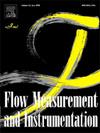Development of empirical models for the modular limit of trapezoidal and triangular throat flumes
IF 2.3
3区 工程技术
Q2 ENGINEERING, MECHANICAL
引用次数: 0
Abstract
One of the essential challenges of flow measurement using the flume structure is whether the flow is free or submerged. Therefore, determining the free-submerged flow boundary is a vital topic. This study experimentally investigates the modular limit/threshold submergence of two kinds of flumes: trapezoidal throat flume (TraTF) and triangular throat flume (TriTF). To this end, the general form of empirical models of the flumes' modular limit index was presented based on dimensional analysis and incomplete self-similarity theory. Then, a set of experimental data was collected. In the next step, empirical relationships were developed using non-linear multivariate regression. The experimental modeling was done in a channel that was 20 m long, 0.6 m wide, and 0.5 m high. A total of 271 tests were conducted, examining nine flumes with trapezoidal throats and four with triangular throats at various flow rates. The TraTF formula has been developed, with 98 % of its predictions having an error of less than 10 % and an average error of 3 %. For the TriTF formula, 96 % of its predictions have an error of less than 10 %, and the average error is 3.6 %.
梯形和三角形喉槽模块极限经验模型的开发
使用水槽结构进行流量测量的基本挑战之一是,水流是自由流动还是沉没流动。因此,确定自由潜流边界是一个重要课题。本研究通过实验研究了梯形喉槽(TraTF)和三角形喉槽(TriTF)这两种水槽的模块极限/淹没阈值。为此,基于维度分析和不完全自相似理论,提出了水槽模块极限指数经验模型的一般形式。然后,收集了一组实验数据。下一步,利用非线性多元回归建立了经验关系。实验建模是在一条长 20 米、宽 0.6 米、高 0.5 米的河道中进行的。共进行了 271 次测试,在不同流速下对 9 个梯形节流孔和 4 个三角形节流孔进行了检验。TraTF 公式已经开发出来,其 98% 的预测误差小于 10%,平均误差为 3%。对于 TriTF 公式,96% 的预测误差小于 10%,平均误差为 3.6%。
本文章由计算机程序翻译,如有差异,请以英文原文为准。
求助全文
约1分钟内获得全文
求助全文
来源期刊

Flow Measurement and Instrumentation
工程技术-工程:机械
CiteScore
4.30
自引率
13.60%
发文量
123
审稿时长
6 months
期刊介绍:
Flow Measurement and Instrumentation is dedicated to disseminating the latest research results on all aspects of flow measurement, in both closed conduits and open channels. The design of flow measurement systems involves a wide variety of multidisciplinary activities including modelling the flow sensor, the fluid flow and the sensor/fluid interactions through the use of computation techniques; the development of advanced transducer systems and their associated signal processing and the laboratory and field assessment of the overall system under ideal and disturbed conditions.
FMI is the essential forum for critical information exchange, and contributions are particularly encouraged in the following areas of interest:
Modelling: the application of mathematical and computational modelling to the interaction of fluid dynamics with flowmeters, including flowmeter behaviour, improved flowmeter design and installation problems. Application of CAD/CAE techniques to flowmeter modelling are eligible.
Design and development: the detailed design of the flowmeter head and/or signal processing aspects of novel flowmeters. Emphasis is given to papers identifying new sensor configurations, multisensor flow measurement systems, non-intrusive flow metering techniques and the application of microelectronic techniques in smart or intelligent systems.
Calibration techniques: including descriptions of new or existing calibration facilities and techniques, calibration data from different flowmeter types, and calibration intercomparison data from different laboratories.
Installation effect data: dealing with the effects of non-ideal flow conditions on flowmeters. Papers combining a theoretical understanding of flowmeter behaviour with experimental work are particularly welcome.
 求助内容:
求助内容: 应助结果提醒方式:
应助结果提醒方式:


